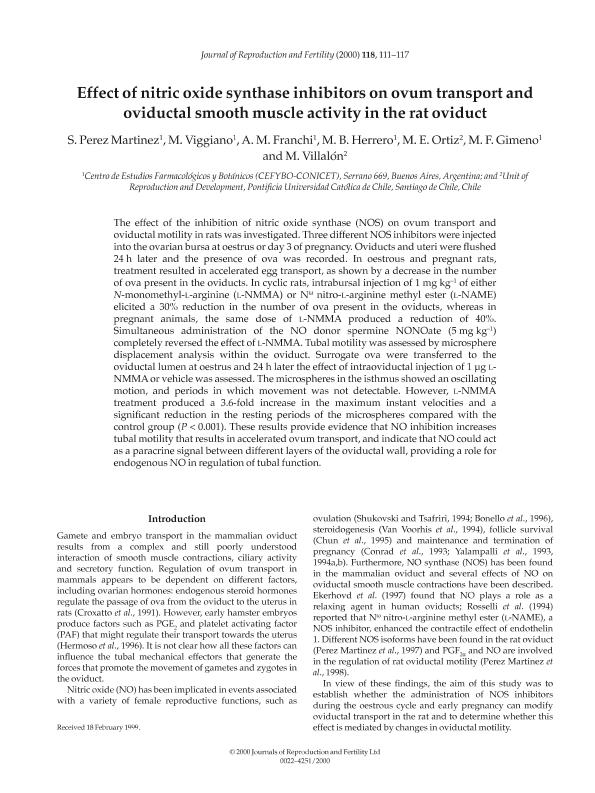Mostrar el registro sencillo del ítem
dc.contributor.author
Perez Martinez, Silvina Laura

dc.contributor.author
Viggiano, M.
dc.contributor.author
Franchi, Ana Maria

dc.contributor.author
Herrero, Maria Belen

dc.contributor.author
Ortiz, M. E.
dc.contributor.author
Gimeno, M. F.
dc.contributor.author
Villalón, M.
dc.date.available
2018-03-28T18:44:05Z
dc.date.issued
2000-01
dc.identifier.citation
Perez Martinez, Silvina Laura; Viggiano, M.; Franchi, Ana Maria; Herrero, Maria Belen; Ortiz, M. E.; et al.; Effect of nitric oxide synthase inhibitors on ovum transport and oviductal smooth muscle activity in the rat oviduct; BioScientifica; Reproduction; 118; 1; 1-2000; 111-117
dc.identifier.issn
1470-1626
dc.identifier.uri
http://hdl.handle.net/11336/40439
dc.description.abstract
Paste another version of the text here.The effect of the inhibition of nitric oxide synthase (NOS) on ovum transport and oviductal motility in rats was investigated. Three different NOS inhibitors were injected into the ovarian bursa at oestrus or day 3 of pregnancy. Oviducts and uteri were flushed 24 h later and the presence of ova was recorded. In oestrous and pregnant rats, treatment resulted in accelerated egg transport, as shown by a decrease in the number of ova present in the oviducts. In cyclic rats, intrabursal injection of 1 mg kg-1 of either N-monomethyl-L-arginine (L-NMMA) or N omega nitro-L-arginine methyl ester (L-NAME) elicited a 30% reduction in the number of ova present in the oviducts, whereas in pregnant animals, the same dose of L-NMMA produced a reduction of 40%. Simultaneous administration of the NO donor spermine NONOate (5 mg kg-1) completely reversed the effect of L-NMMA. Tubal motility was assessed by microsphere displacement analysis within the oviduct. Surrogate ova were transferred to the oviductal lumen at oestrus and 24 h later the effect of intraoviductal injection of 1 microgram L-NMMA or vehicle was assessed. The microspheres in the isthmus showed an oscillating motion, and periods in which movement was not detectable. However, L-NMMA treatment produced a 3.6-fold increase in the maximum instant velocities and a significant reduction in the resting periods of the microspheres compared with the control group (P < 0.001). These results provide evidence that NO inhibition increases tubal motility that results in accelerated ovum transport, and indicate that NO could act as a paracrine signal between different layers of the oviductal wall, providing a role for endogenous NO in regulation of tubal function.
dc.format
application/pdf
dc.language.iso
eng
dc.publisher
BioScientifica

dc.rights
info:eu-repo/semantics/openAccess
dc.rights.uri
https://creativecommons.org/licenses/by-nc-sa/2.5/ar/
dc.subject
Nitric Oxide
dc.subject
Ovum Transport
dc.subject
Oviductal Activity
dc.subject.classification
Fisiología

dc.subject.classification
Medicina Básica

dc.subject.classification
CIENCIAS MÉDICAS Y DE LA SALUD

dc.title
Effect of nitric oxide synthase inhibitors on ovum transport and oviductal smooth muscle activity in the rat oviduct
dc.type
info:eu-repo/semantics/article
dc.type
info:ar-repo/semantics/artículo
dc.type
info:eu-repo/semantics/publishedVersion
dc.date.updated
2018-03-16T15:15:16Z
dc.journal.volume
118
dc.journal.number
1
dc.journal.pagination
111-117
dc.journal.pais
Reino Unido

dc.journal.ciudad
Bristol
dc.description.fil
Fil: Perez Martinez, Silvina Laura. Consejo Nacional de Investigaciones Científicas y Técnicas. Oficina de Coordinación Administrativa Houssay. Centro de Estudios Farmacológicos y Botánicos. Universidad de Buenos Aires. Facultad de Medicina. Centro de Estudios Farmacológicos y Botánicos; Argentina
dc.description.fil
Fil: Viggiano, M.. Consejo Nacional de Investigaciones Científicas y Técnicas. Oficina de Coordinación Administrativa Houssay. Centro de Estudios Farmacológicos y Botánicos. Universidad de Buenos Aires. Facultad de Medicina. Centro de Estudios Farmacológicos y Botánicos; Argentina
dc.description.fil
Fil: Franchi, Ana Maria. Consejo Nacional de Investigaciones Científicas y Técnicas. Oficina de Coordinación Administrativa Houssay. Centro de Estudios Farmacológicos y Botánicos. Universidad de Buenos Aires. Facultad de Medicina. Centro de Estudios Farmacológicos y Botánicos; Argentina
dc.description.fil
Fil: Herrero, Maria Belen. Consejo Nacional de Investigaciones Científicas y Técnicas. Oficina de Coordinación Administrativa Houssay. Centro de Estudios Farmacológicos y Botánicos. Universidad de Buenos Aires. Facultad de Medicina. Centro de Estudios Farmacológicos y Botánicos; Argentina
dc.description.fil
Fil: Ortiz, M. E.. Pontificia Universidad Católica de Chile; Chile
dc.description.fil
Fil: Gimeno, M. F.. Consejo Nacional de Investigaciones Científicas y Técnicas. Oficina de Coordinación Administrativa Houssay. Centro de Estudios Farmacológicos y Botánicos. Universidad de Buenos Aires. Facultad de Medicina. Centro de Estudios Farmacológicos y Botánicos; Argentina
dc.description.fil
Fil: Villalón, M.. Pontificia Universidad Católica de Chile; Chile
dc.journal.title
Reproduction

dc.relation.alternativeid
info:eu-repo/semantics/altIdentifier/url/http://www.reproduction-online.org/content/118/1/111.long
dc.relation.alternativeid
info:eu-repo/semantics/altIdentifier/doi/http://dx.doi.org/10.1530/jrf.0.1180111
Archivos asociados
